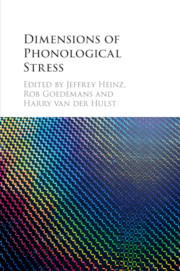Book contents
- Dimensions of Phonological Stress
- Dimensions of Phonological Stress
- Copyright page
- Contents
- Figures
- Tables
- Contributors
- Introduction
- 1 Metrical Incoherence: Diachronic Sources and Synchronic Analysis
- 2 The Role of Phenomenal Accent
- 3 Foot Alignment in Spanish Secondary Stress
- 4 The Interaction of Metrical Structure and Tone in Standard Chinese
- 5 Prominence, Contrast, and the Functional Load Hypothesis: An Acoustic Investigation
- 6 Iquito: The Prosodic Colon and Evaluation of OT Stress Accounts
- 7 Investigating the Efficiency of Parsing Strategies for the Gradual Learning Algorithm
- 8 Covert Representations, Contrast, and the Acquisition of Lexical Accent
- 9 One or Many? In Search of the Default Stress in Greek
- 10 The Development of Rhythmic Preferences by Dutch-learning Infants
- 11 Acoustic Characteristics of Infant-directed Speech as a Function of Prosodic Typology
- Index
- References
2 - The Role of Phenomenal Accent
Published online by Cambridge University Press: 25 November 2016
- Dimensions of Phonological Stress
- Dimensions of Phonological Stress
- Copyright page
- Contents
- Figures
- Tables
- Contributors
- Introduction
- 1 Metrical Incoherence: Diachronic Sources and Synchronic Analysis
- 2 The Role of Phenomenal Accent
- 3 Foot Alignment in Spanish Secondary Stress
- 4 The Interaction of Metrical Structure and Tone in Standard Chinese
- 5 Prominence, Contrast, and the Functional Load Hypothesis: An Acoustic Investigation
- 6 Iquito: The Prosodic Colon and Evaluation of OT Stress Accounts
- 7 Investigating the Efficiency of Parsing Strategies for the Gradual Learning Algorithm
- 8 Covert Representations, Contrast, and the Acquisition of Lexical Accent
- 9 One or Many? In Search of the Default Stress in Greek
- 10 The Development of Rhythmic Preferences by Dutch-learning Infants
- 11 Acoustic Characteristics of Infant-directed Speech as a Function of Prosodic Typology
- Index
- References
- Type
- Chapter
- Information
- Dimensions of Phonological Stress , pp. 49 - 78Publisher: Cambridge University PressPrint publication year: 2016
References
- 1
- Cited by

